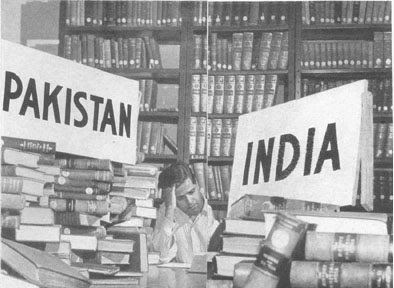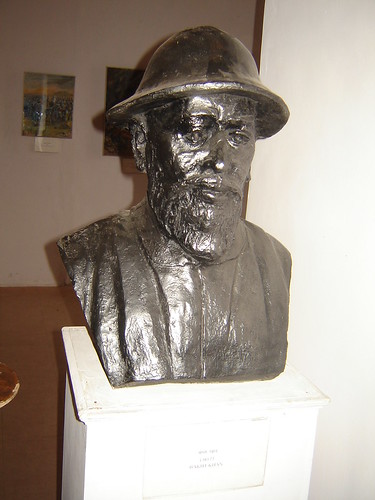
Page-1
|Page-2
|Page-3|Page-5|Page-6
|Page-7
|Page-8
|Page-9
| Page-10
| BaKhabar  Download pdf Download pdf
|
| Useful
idiots (UI) --- By S.G. Jilanee <sjila_104@hotmail.com>* Biharis were driven out of
their
homes and packed off to ghettos, massacred in thousands regardless of
gender or age, raped with abandon. Many were killed simply by draining
off their blood with hypodermic syringes. At the railway junction of
Santahar alone, the entire Bihari population of several thousand men,
women and children was totally wiped out.
In this historical masterpiece, the author, a Bihari-tuned-Pakistani recounts a macabre idiocy of Bihari muslims who supported the formation of Pakistan, and happily migrated to East Pakistan, now Bangladesh.  Attributed to Lenin, Useful Idiots (UI) was a derogatory remark about Soviet sympathizers in the West who supported the Soviet leadership blindly. Later it was extended to apply to people who act as propagandists for a cause whose goals they do not understand and support its leadership come what may. The useful idiots, for their part, claim their unflinching loyalty as proof of their lofty character. The sobriquet applies most perfectly to the Muslims of the Indian state of Bihar. These Bihari Muslims did not understand the goals of the All-India Muslim League’s demand for a separate homeland for the “Mussalmans of India.” Yet, they went totally berserk in support of the cause. A glaring example was the president of the Bihar provincial Muslim League, Syed Abdul Aziz. He sold off his sprawling mansion and his mica mine to meet the expenses of hosting the twenty-sixth Session of the League in December 1938 at the provincial capital, Patna.  Situated between the Exhibition and Fraser Roads and overlooking the vast Race Course ground, the compound of the building covered several acres of the choicest property in the city. A fabulous pandal was erected. Dazzling illumination turned night into day and a mass of people never seen before (or after) filled the vast race course ground. At the dais sat League President, Mohammad Ali Jinnah, in the centre with other top leaders of the party on either side. Granted, the event was a grand success; that it was historic. But did it have to be this way? The U.P. had a surfeit of nawabs of all sizes and dimensions. Punjab mushroomed with Maliks and Sardars. But none ever put up such show. Only the UI syndrome can explain this senseless waste of money because, obviously, Barrister Abdul Aziz did not clearly understand the real purpose of the “cause” he was supporting with such ardour. It was revealed when the Liaqat-Nehru Pact excluded Bihar from “agreed areas” with regard to compensation for abandoned properties. Nor was it a stray case of an individual. A collective display of the UI disease was exhibited by the Biharis who migrated to East Pakistan. Committed to “Pakistan”, they believed that the West Pakistanis were its true saviours. Because they poke Urdu, they jumped with alacrity at the declaration that Urdu “and Urdu alone” would be Pakistan’s national language. Typically they shut their eyes to the reality around them and opposed the aspirations of the indigenous people. In 1954 the first anti-Bihari riots erupted at the Adamjee Jute Mills in Narayanganj as soon as the Jukta Frontgovernment was sworn in defeating the Muslim League. But the Biharis ignored the clear signal and went on with their lives merrily, smug in the belief that the West Pakistan will get them through. Their “useful idiocy” reached its apogee in 1971 when they allied with the Pakistan army in its crackdown against Bengalis. They enlisted in the Jamaat-e-Islami’s marauding hordes of Al Shams, Al Badr, the army’s razakar militia and the East Pakistan Civil Armed Force (EPCAF) hunting down the local people.  When reckoning came, their mentors vanished leaving them behind to face the “music,” whose dreadful strains were spine-chilling. Biharis were driven out of their homes and packed off to ghettos, massacred in thousands regardless of gender or age, raped with abandon. Many were killed simply by draining off their blood with hypodermic syringes. At the railway junction of Santahar alone, the entire Bihari population of several thousand men, women and children was totally wiped out. The Jamaat-e-Islami abandoned them. The army disowned them. Opposition to their repatriation and rehabilitation in Pakistan was so intense that philanthropists, such as Ahmad E.H. Jaffer and Lord Ennals, as well as the Mo’tamar-e-Alam-e-Islami had to give up efforts to collect funds for the purpose. But, despite the miserable life in the “relief camps” in Bangladesh, the Biharis went on to unfurl Pakistan flag on 23 March and 14 August. Many have since died. Yet, as true symbols of Useful Idiots, the few that are still living, have their faith unshaken in the fantasy that they will one day be going “home” to Pakistan.    |
Bakht
Khan: Winner of a lost battle –
Part1
… By Asma Anjum*
A much
garlanded and battle hardened veteran of Afghan wars, with huge
handlebar moustache and sprouting sideburns…. Known personally to
several of the British officers.
 Second of July 1857, a hot humid day some one hundred and fifty-five summers ago, a contingent of about 250 men in their Bareilly regiment uniforms arrives in Dilli of the time, the world renowned Red Fort to be precise. Mounted on their horses, they march past the Laal Purdah [1][entrance to the private chambers of the last Mughal King]. The General of the regiment marches too albeit without the customary bowing down of his head; much to the outrage of those present at the court. But what happens next would seem rather more sacrilegious. That unbending commander of the arriving regiment, a tall and corpulent man of Rohilla stock appears least caring about the sensation he creates and the protest that comes his way, he moves forward and ‘salaams’ the King as if he is an equal.[2] But the King, Zille Sub-haani, Khaleefatur Rehmani, Khudawand e Majaazi, Hazrat Abul Zafar Sirajuddin Bahadur Shah Zafar is helpless. The man in the eye of this little storm was General Bakht Khan, Commander of the Neemuch brigade, of the Army of East India Company, among the true heroes of 1857, who had arrived to make a fight against the Company which till now he had served. General Bakht Khan's bust in Red Fort museum. He was described as “a much garlanded and battle hardened veteran of Afghan wars, with huge handlebar moustache and sprouting sideburns…. Known personally to several of the British officers” [3] His reputation as an able administrator and a shrewd military strategist had reached Delhi much before his arrival. The poor Mughal King, after much reluctance, decides to award the just landed General ,a royal sword and a buckle but Bakht Khan still refuses to present the ‘nazar’ (a mandatory monetary gift to be offered to the King) when meeting him. Soon after, this Khan then begins to give a piece of his mind to the king, he begins, “Your good for nothing princes [sons] enjoy full powers over your military. Give all the power to me as no one else but I know the norms of the English army, who knows them better than me?” This was blunt and undiplomatic at its best, but the man in question, meant business. He was duly appointed the Governor General of the army, effectively displacing Mirza Mughal the headstrong son of Zafar. Reading literature about 1857 revolution became quite an obsession with me since a teenager, our shared history of the sub-continent, India, Pakistan and Bangladesh. A familiar heritage we possess, a common thread running through our past. History is journalism with hindsight and this special journalism about 1857 period transports us to a novel world inducing in us a sense of déjà vu. It was through these readings that I ‘discovered,/em>’ Bakht Khan. But it was not love at first sight; I must tell you, what with his being a man with a pot belly that did not make him a fine horseman! Add to it the derision he was subjected to contemptuously for the reason of his being a Wahabi. But more surprising were the contradictions that I began noticing in various descriptions about him. A few, mostly historians from the east, respected him as one of the bravest soldiers and the real hero of 1857 Ghadar while the rest seem to scorn him just for being a Wahabi. This term in itself is quite controversial, even today, just as it was in those days. Wahabism is the name given to Islamic philosophy instituted by Muhammad ibn Abdul Wahab Najdi[1703-1792] in 7th Century Arabia; the intention was to practice Islam it in its purity just as Prophet Muhommad (peace be upon him) did. William Dalrymple elaborates General Bakht Khan‘s Wahabism thus, “Like a Wahabi ,” he says, “Bakht Khan disdained earthly rulers, whom he regarded as unIslamic, and longed instead for a properly Islamic regime.” [4] He cites his Wahabist thoughts to be a cause of his failure. Interestingly , Bakht Khan fought under a king who was the embodiment of everything a true Wahabi abhors. What is astonishing is that in almost every account about the man, his being a Wahabi is essentially stressed, perhaps to draw attention to his real or imagined fanaticism. Some of the earlier prominent revolutionary figures like Syed Ahmed Shaheed and Shah Ismaeel Shaheed were self-proclaimed Wahabis. Let’s see what Bakht Khan‘s Wahabism was like. His Wahabism was said to have been inspired by his spiritual mentor, Moulvi Srafaraz Ali, a master teacher of Algebra and Geometry and with a thorough knowledge of Tafseer[Quranic interpretations] and Hadeeth [Prophet Muhammad‘s sayings]. Moulvi Sarfaraz Ali was entitled as Imam of Mujahideen and his orations exhorted people to join this revolution. It was he who had motivated his initially reluctant disciple Bakht Khan to join this momentous struggle. In the pre- revolution time, Moulvi Sarfaraz Ali was regarded as one of the brightest jewels in Delhi’s intellectual crown, by no less than Sir Sayyed Ahmad Khan himself. So it was Moulvi Sarfaraz Ali who urged Bakht Khan to fight against the infidel Christians for the honor of his country. Interestingly this ‘accusation’ of his being a Wahabi also betrays probable renaissance Islamic nature of the revolution of 1857. Being a Wahabi, Bakht Khan was against the veneration of Sufi shrines, which was/is quite a rampant practice among a large section of the Indian Muslims. The Wahabis disapprove of it as being nearer to idol worship and a tendency picked up from their Hindu brothers. What is important to be noted and not to be overlooked is; this Wahabism of Bakht Khan and his mentor Moulvi Sarfaraz Ali was borrowed not from Abdul Wahab Najdi of Saudi Arab but from Shah Waliullah Muhaddith Dehalvi [1703-1762], the father of Islamic reform movement in India. This reform movement aimed at eliminating all non-Islamic innovations and practices from the religion and restoring a strict Islamic monotheism, among Indian Muslims. Shah Waliullah, was the first one to translate Quran into Persian and anticipated many modern, social, economic and political thoughts, such as social reform, equal rights, labour protection, and welfare entitlement of all.  * Asma Anjum (Khan), a social reformer, is exploring the partition of India with a view to understand the largest political divide of muslims in the 21st century. She can be contacted on asmaanjum.khan@gmail.com |
|
4
Home
| About
Us | Objective
| Scholarship
| Matrimonial
| Video
Library | Projects | Quran
Resources | Lend
a hand
|